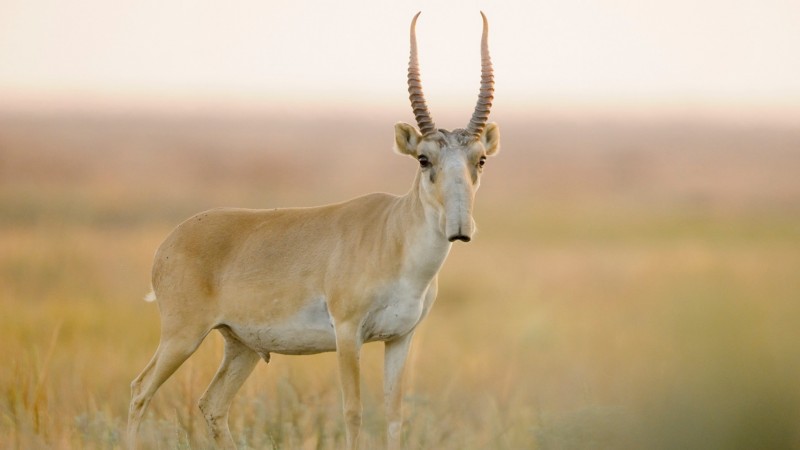In 1993, with the goal of conserving the Mongolian saiga antelope, the State Great Khural of Mongolia declared the establishment of the Sharga Mankhan Nature Reserve, placing it under special state protection. This reserve consists of two geographically separate areas located about 200 kilometers apart: the Sharga region in the Gobi-Altai Province (covering the territories of Sharga, Tugrug, Tonkhil, Darvi, and Khaliun soums) and the Mankhan region in the Khovd Province (covering Buyant and Mankhan soums).
The main purpose of the Sharga Nature Reserve is to preserve the original condition of the desert steppe ecosystem, including its soil, vegetation, and wildlife, and particularly to protect and restore the native Mongolian saiga population. Sharga Gobi, located in the central part of the Mongol Altai Mountains, is a flat desert steppe area with salt flats surrounding Shargiin Tsagaan Lake. The area is known for its arid, gravelly soil and the diversity of geographic zones and altitudinal belts within short distances.

Sharga Depression is surrounded by the main range of the Mongol Altai to the south, the Darvi range to the northwest and north, and the Hasagtkhairkhan and its branches to the northeast. It is dissected by seasonal streams originating from these mountain ranges. The depression stretches east-west for 150–160 kilometers and north-south for 70–80 kilometers, forming a deep basin. The surface consists mostly of saline sands, with dunes and hummocks. Although small rivers and streams flow down from the mountains, they quickly disappear into the arid land. Numerous springs, streams, and rivers originating from the Altai Mountains provide water sources for saigas and black-tailed gazelles.
Important springs in the Sharga side include Tungalag, Tokhom, Ögöömör, and in the Mankhan side – Shine Us, Zadgai, and Dalan Türüü. These springs also support herder households. Although there are shallow, saline lakes like Ikhes and Sharga in the Gobi, their high mineral content makes them unsuitable for saigas to drink from.
Sharga Gobi, located in the Great Lakes Depression, experiences extremely dry conditions due to its deep inland location in Central Asia. Moist air currents from the Atlantic Ocean and the Arctic lose most of their humidity while passing over the vast expanses of Europe and Asia before reaching this region.

Precipitation Levels in the Sharga Mankhan Area
Precipitation, the main source of soil and atmospheric moisture, is very limited in the Sharga-Mankhan area, with an annual average of no more than 122 mm. In drought years, this can drop to as little as 90–100 mm. About 70–80% of the annual precipitation falls in the summer, often as intense thunderstorms or hail, which are poorly absorbed by the dry soil and mostly run off or evaporate quickly. Snow cover in winter is thin, usually only 2–3 cm deep.
Air Temperature
The Sharga Mankhan Valley is surrounded by high mountain ranges, which significantly influence the region’s climate. These mountains help retain the cold air masses during winter and the dry, hot air masses arriving from the south in summer, leading to extreme seasonal temperature fluctuations.
For example, the highest recorded air temperature during the warmest month, July, reaches +35.8°C, while the lowest recorded temperature during the coldest month, January, drops to −33.3°C, resulting in an absolute temperature range of 69.1°C. This wide range is not limited to extreme values only; a notable contrast is also observed in the average monthly temperatures. In January, the average air temperature is −23.1°C, whereas in July, it rises to +20.9°C, creating an average temperature difference of 44.0°C between the coldest and warmest months.
The long-term annual average air temperature in the Sharga-Mankhan region is approximately −1.5°C.
Soil
The area is characterized by desert gray-brown, semi-desert brown, and extremely arid desert soils.
Vegetation
Vegetation in the Sharga Depression includes shrub groups such as saxaul, eurotia, feather grass–perennial forbs, reed grass, and red saltwort. In the Mankhan region, feather grass–perennial forbs, halophytes, rock steppe, and eurotia–reed associations dominate. Common species include wild onion (Allium), wormwood (Artemisia), saxaul (Haloxylon), tamarisk (Tamarix), and ephedra (Ephedra).
Wildlife
In the Sharga Depression, herds of black-tailed gazelles inhabit areas such as the Khuren River Valley, Khatny Khudag, Baga Darvi, and the foothills of the Jargalant Mountains. Wolves and foxes pass through the area seasonally, while mountain habitats support snow leopards and lynxes. Birds of prey, including golden eagles, lammergeiers, steppe eagles, and buzzards, are also found here. The Mongolian saiga (Saiga tatarica mongolica) is the flagship species of the Sharga Mankhan Nature Reserve.